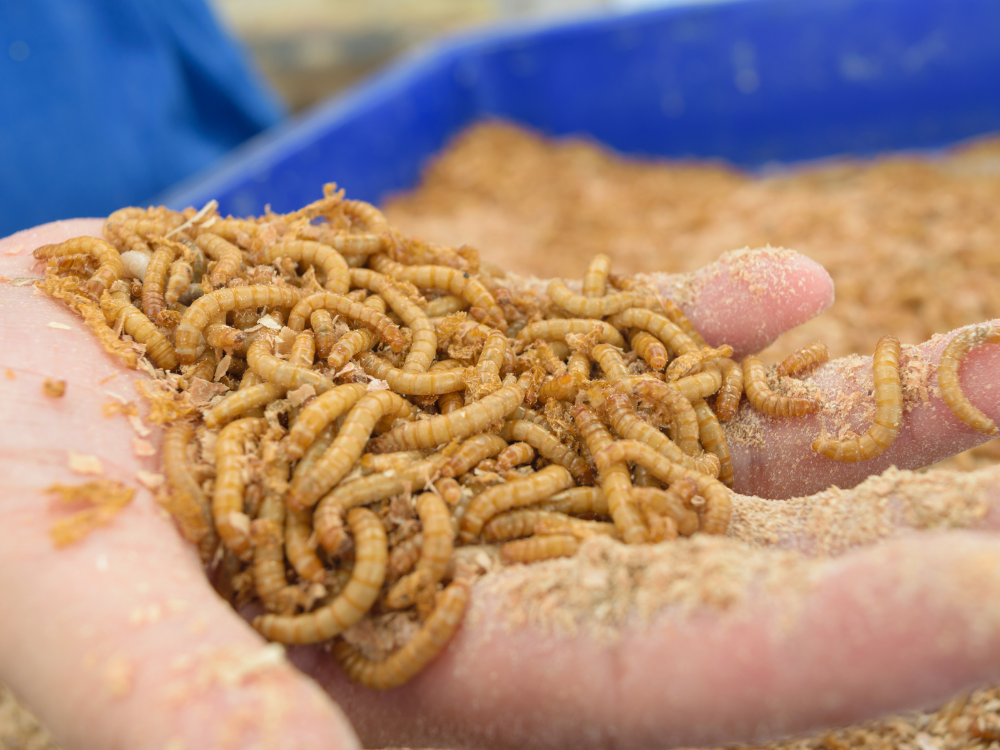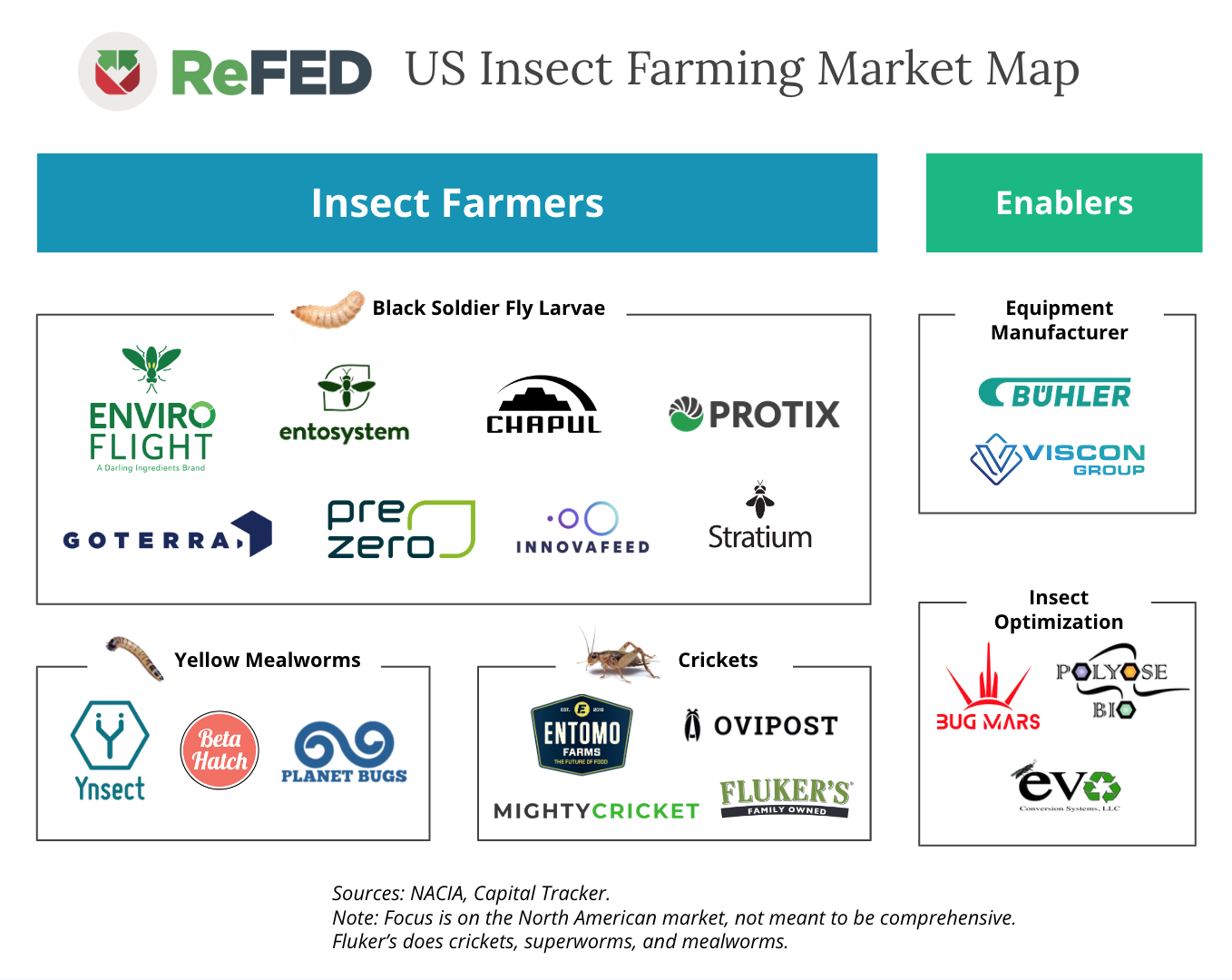What can be done about the large amounts of food loss and waste from manufacturing and at the consumer level that are destined for landfill? What we’ve been seeing now is that to solve a problem brought on by excess, technology, and industry, humans are turning to nature. Insects — often overlooked in our everyday lives — are being called upon to serve! How, you ask? To put it simply, insects enjoy dining on our food waste and in return produce valuable products for agriculture and other uses.
In North America, insect farming has existed for a number of years to provide specialty protein for pets (think lizards and fish). However, in the early 2010s, insect protein was presented as an alternative protein for human consumption by some enterprising startups inspired by businesses already marketing insect-based food products outside of the U.S. They were making a bet that insects would become more palatable for the taste preferences of U.S. consumers seeking to live more sustainability. It is safe to say that those companies were a little too early for the American market though. While there are still companies today seeking to convince consumers to consume a range of products derived from insects, the road is long — with heavy investment on education still required, and a behavior shift that isn’t forthcoming. More recently, companies have refocused their efforts on animal feed for farming and ranching, as well as fertilizer markets. And while this has avoided some of the behavior change barriers, it still has had its challenges.
When we refer to "insects," we are really talking about three types that are commonly farmed in the U.S.: crickets, black soldier fly larvae, and yellow mealworms. This is important, because each of these insects has different nutritional properties (i.e., mixes of protein, fat, and other nutrients) and therefore different applications (e.g., crickets and yellow mealworms for human food, black soldier fly larvae for animal feed). (Stratium has developed a good illustrative framework to explain the differences.) The insects that seem to have the greatest promise for consuming food waste are black soldier fly larvae, as they are effectively the least “picky.” Mealworms can only consume certain types of waste, and crickets for the most part have been strictly on feed/chicken feed, but none of these rules are hard and fast, as the black soldier fly larvae sector appears the most advanced due to it being the most researched. There is continued experimentation with the nutritional benefits of other insects, as well as their ability to consume food waste.

Business Model Experimentation
Insect farming is mostly centralized, featuring a warehouse-like facility intaking food waste or low-value commodities that are then fed to the insects. Food waste is far more localized, which changes the business model calculations. The "make or break" for any food waste diversion solution is logistics — being able to move and "purchase" feedstock economically. As a result, distributed models are being developed, including building modular facilities on-site at farms, manufacturers, and other food producers. This prospect introduces many innovative business models ranging from selling hardware/software as a license to having purchase agreements on the grown insects. Ideally, post-consumer waste would be used as the feedstock for insects, but unfortunately there isn’t enough consistency.
The component of the insect agriculture business model that has been in flux is off-take for the end-products. Selling insects for livestock feed requires scale that may be difficult to achieve with food waste as feedstock, as it is expensive to consolidate all feedstock to have enough volume to be able to lower costs. Additionally, insects are competing against other cheap protein sources (soy, etc.) which are skewed by subsidies. Some companies are supporting their businesses by producing livestock feed for local use, as well as exporting food to other countries, while they wait for human taste preferences in the U.S. to change — and with that the promise of higher margins. It is notable that market leader Ynsect — in a move to focus on profitability — has transitioned to focus on the pet and human food sectors. Ynsect has achieved significant scale by using agricultural byproducts as feedstock for its insects, but reading between the lines of this development at the company, even at scale they haven’t gotten livestock feed right yet. The upside case for revenues is that these facilities also create "frass" (which is basically insect waste and exoskeletons) that can be used as an organic fertilizer. This market is still in its infancy and does not exist today.
That being said, insect farmers are positioning their product (whole or as an additive to feed) relative to incumbents by focusing on the non-financial benefits — such as nutritional benefit, reduction in food loss, and lower land requirements and carbon emissions — which offset the higher costs. And when used as an additive, insect-derived products don't need to compose all the feed, but just can be added to improve quality.
Our Multi-Legged Key Players
Maybe it is overexuberance, but established global insect farmers believe the U.S. market is ready, and they have started expanding. InnovaFeed is expanding its vertical insect farms to the U.S. on the back of a $250M raise and with food giants ADM and Cargill participating as both customers and investors. Their expansion follows corn production in the U.S., as it did wheat production in Europe. Quickly responding to this, Ynsect will begin construction of a large-scale farm in the U.S. and Mexico by late 2023. And partnerships like Bühler and Entocycle seek to provide end-to-end solutions to those thinking of entering the insect farming industry without the need to go through the whole trial-and-error process of building a solution. This should reduce barriers to entry. It is notable that large platforms such as Darling Ingredients (through their purchase of Enviroflight) and Lidl (through their acquisition of recycler PreZero) have insect farming operations. Lastly, we are seeing companies turn to automation as a means to reduce costs which should help the industry be more competitive relative to incumbent sources of protein. And most recently, companies are even exploring novel ways of adjusting insect genetics.
Below are models that we have seen:

Bringing this all together is the North American Coalition for Insect Agriculture (NACIA), which is trying to educate and help build awareness and acceptance for insects to upcycle nutrients up the food chain. They have been doing great work in establishing the sector, in particular, by handling the regulatory work which would have been onerous if taken on by individual companies.
What Do Funders Think?
Through our conversations with potential and current funders, there is a growing perception that this sector needs time and might not provide traditional venture capital returns. Many of the opportunities and concerns previously raised by our friends at Tenacious Ventures (a Food Waste Funder Circle member) are still relevant today.
There are a few common lessons and questions that we have come across:
-
Can this scale? With margins low, are there ways that costs can come down? Can the supply of insects be consistent enough to be adopted by businesses (and related, is there enough of a consistent supply of waste feedstock to allow for this)?
-
Execution over patents. Although many companies do employ proprietary growing practices through their research into specific blends to feed insects, this is rather difficult to defend via patent. In order to win in this space — honestly, it is about great execution — being able to turn over feedstock into sales of insect products and having strong relationships with both waste suppliers and food businesses are absolutely critical.
-
Insect asset class hard to pin down. Given business models are fairly asset-heavy and food system change is slow, it is an odd fit for venture investors. Investors should not expect traditional infrastructure returns either, since long-term agreements do not exist for these companies. They should be viewed as ingredients manufacturers and therefore probably more fit for strategic partners, private equity, and creative/impact investors.
-
Regulatory hurdles, no. Onerous, yes. Given it is a food product, it needs to meet standards that have not been set yet. NACIA is helping lay the foundation to navigate these challenges to business models which should help companies access other funds like USDA, etc. That being said, this again takes time.
Why Is This Interesting For Us Now?
It appears we are at the point where there are many companies that are either in the process of being scaled, on the cusp of implementation (based on milestones), or improving on processes of insect rearing. We are seeing the U.S. market playing out with large international insect farmers targeting large food manufacturers. Local innovators are setting up large facilities of their own in their geography, mostly through a centralized approach, although some are flirting with the idea of shifting to on-prem or distributed once they have refined their existing operations. Globally, it seems we are now regularly hearing about new startups opening facilities.
This part leaves us bug-eyed with excitement, because we will actually see if these models will work in the wild.
Other resources to check out:
